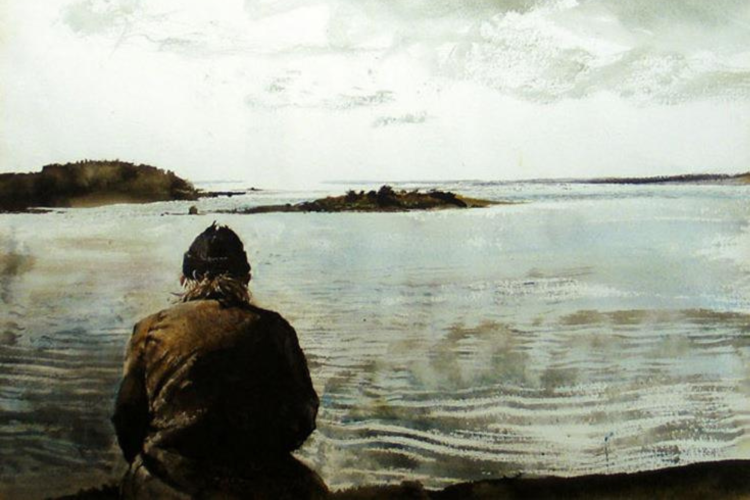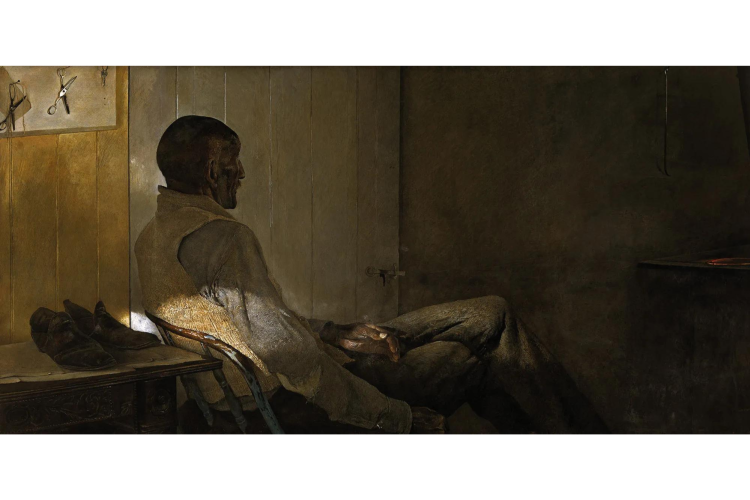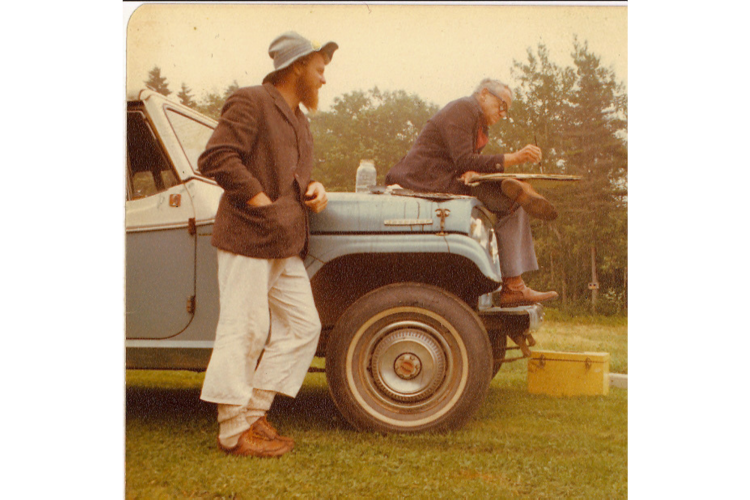Andrew Wyeth Paintings: 13 Iconic Works and His Legacy in 2025

Muted, moody and quietly powerful — Andrew Wyeth paintings show rural life with a clarity that feels unexpectedly real. His realist style, often mistaken for photographic detail, asks you to slow down and take it all in. Some works hit with a gentle emotion, others just stay with you. Instead of simply capturing a likeness, he aimed to stir feelings, often solitude, nostalgia or a quiet tension.
And audiences haven’t lost interest. The Brandywine Museum recently opened Abstract Flash: Unseen Andrew Wyeth, showcasing 37 never-before-seen watercolors. From museum retrospectives to the ongoing popularity of Andrew Wyeth prints, his work continues to resonate with new audiences.
While art historians may focus on technique or symbolism, many fans simply connect with the feeling his work evokes — a sense of quiet observation and emotional distance. From his early success in the 1930s to the enduring popularity of Andrew Wyeth prints and exhibitions, his legacy continues to shape American art.
Jump to Section
- Who Was Andrew Wyeth?
- Why Andrew Wyeth Still Matters
- What Makes Andrew Wyeth Paintings Unique?
- Andrew Wyeth and Christina’s World
- The Best Andrew Wyeth Paintings
- Andrew Wyeth Paintings and the Legacy of the Wyeth Family
- Where to See or Buy Andrew Wyeth Paintings
Who Was Andrew Wyeth?

Andrew Wyeth was one of the most prominent American painters of the 20th century, best known for his realistic yet deeply expressive portraits and landscapes. He didn’t just stick to the regionalist style either, he also dabbled with the abstract, often known to portray normal objects in a new way, designed to create a mood.
Born in 1917 in Chadds Ford, Pennsylvania, he was the youngest of five children and grew up under the guidance of his father, the famous illustrator N.C. Wyeth. Due to fragile health, Andrew was homeschooled and trained privately in art.
He started painting seriously in his teen years, experimenting with watercolor in the tradition of Winslow Homer. His first solo exhibition in 1937 sold out — a rare accomplishment that catapulted him into national prominence. Many of the earliest Andrew Wyeth paintings were done in this Old Master style (think Renaissance paintings).
Wyeth spent most of his life between Pennsylvania and Maine, quietly documenting the people and places around him. Christina Olson, the muse for Christina’s World, and Helga Testorf, from the Helga Pictures, two of his most well-known models, helped shape many of the Andrew Wyeth paintings that define his legacy. His style varied across his career as he tried new techniques and subjects, though he always returned to his love of landscapes and human figures.
Why Andrew Wyeth Still Matters
Wyeth is considered one of the most famous painters of modern times, and his notoriety continues even after his passing in 2009. While some might describe his work as melancholic, due to the moody, earthy hues and sometimes somber scenes, he preferred to think of it as thoughtful.
He was a man who loved solitude and received no formal training, yet managed to reach stardom in the 20th century, with many of his works still on display at the Museum of Modern Art, the Museum of Fine Arts Boston, and the Brandywine River Museum of Art.
What Makes Andrew Wyeth Paintings Unique?

Andrew Wyeth’s painting style evolved throughout his life, shifting as he explored new techniques. While landscapes and people remained central themes, his approach to depicting them grew more refined over time.
He typically began with pencil or watercolor sketches, then layered in detail using dry brush, additional watercolor or egg tempera, a method he learned from his brother-in-law. Unlike Impressionist paintings, which focus on fleeting light and movement, Wyeth’s work captures softness through precision, with forms that blur at the edges but never lose structure. Watercolor painting for beginners can be a great way to understand this effect, and Wyeth’s landscapes, much like Georgia O'Keefe paintings, show how nature scenes can be both delicate and deeply expressive. Many also make ideal watercolor painting ideas.
Wyeth’s work is often described as both “regionalist” and abstract. Regionalist art, popular in the 1920s–1940s, reflected rural American life with undertones of folklore and Great Depression hardship — a sensibility echoed in Norman Rockwell Paintings and even the more sentimental tone of Thomas Kinkade Paintings. Yet Wyeth’s version is more introspective and restrained. And while “abstract” might not seem to fit his realist style, he used mood, composition and muted color to suggest emotion without spelling it out — not unlike Andy Warhol Paintings, though with very different intent.
That emotional subtlety is part of what still draws collectors. Interest in Andrew Wyeth prints remains strong, evidenced by auction houses reporting signed print collections fetching well into the tens of millions.
Andrew Wyeth and Christina’s World
1. Christina’s World (1948)

Painted in 1948, Christina’s World remains the most iconic Andrew Wyeth paintings. It shows a young woman crawling through the grass, surrounded by a dull Maine landscape, making her way towards a gray barn in the distance. Andrew Wyeth's paintings of Christina's World have become one of the most recognized American paintings of the 20th century. Christina Olson, who had a neurological condition affecting her mobility, served as Wyeth’s model and muse for years.
You can see Christina’s World at the Museum of Modern Art (MoMA) in New York City.
The Best Andrew Wyeth Paintings
Alongside Christina’s World, these are some of Andrew Wyeth paintings — each capturing a different aspect of his style, subjects or emotional depth.
2. Wind From The Sea (1947)

An interior view from the Olson home with curtains billowing inward shows the view from inside the Olsons’ home. The curtains are captured with such lightness that they appear more like a photograph than a painting. Through the window, you can see a meandering road and a body of water.
3. Evening at Kuerners (1970)

One of several Andrew Wyeth paintings of the Kuerner farm, this particular work shows an evening view with barren trees and a thin stream. The dark, muted colors create a certain feeling of dreadfulness or desolation, reflecting Wyeth’s emotional connection to the place and the people, painted at a time when Karl Kuerner Jr., the son of the owner, was ailing.
4. Trodden Weed (1951)

This self-referential piece shows only a pair of high leather boots, a Christmas gift from Wyeth’s wife that once belonged to his father’s teacher, a man he deeply admired. Painted while recovering from surgery, the scene is sullen but symbolic, more about memory and legacy than the ground beneath the boots. Like many Andrew Wyeth paintings, it carries a quiet, personal weight that lingers.
5. That Gentleman (1960)

A portrait of Tom Clark, an African American neighbor, was painted with warm, subdued tones and quiet reverence. Seen only from behind and in partial profile, Clark is cast in a soft brown aura that blurs detail and sharpens mood. A single shard of light cuts through the darkness, adding weight to Wyeth’s own description of Clark as witty, wise and gentle.
6. Winter (1946)

Painted after the death of Wyeth’s father, this landscape shows a lone figure descending a barren hill. The grass is dull, the sky heavy, and just a trace of snow clings near the fence. Like many Andrew Wyeth paintings, the scene is spare but loaded with feeling, a reflection of what Wyeth called his own “sea of grief” during that time.
7. November First (1950)

The muted hues paint a picture of bitter cold, with little to no sunshine or hope to be found. A certain dampness is in the air, conveyed through shades of dark gray and brown. It showcases both decay and imminent renewal at once. It’s one of Wyeth’s simplest, yet most emotionally resonant works.
8. The Patriot (1964)

Ralph Cline, a proud World War I veteran, is the subject of this portrait. Wyeth described him as “absolutely the patriot,” noting that the American flag meant everything to him. It’s a warmer, more uplifting portrayal than many Andrew Wyeth Paintings. The portrait was later featured in Life magazine and hung at West Point, before being moved to a private collection.
9. Perpetual Care (1961)

One of the more austere Andrew Wyeth paintings, this work depicts a cemetery behind a Baptist church near his summer home in Cushing, Maine. The headstones and the church’s steeple symbolize the church as a gateway to the afterlife. The color scheme is dull and simple, with striking detail, right down to the blades of grass in the foreground. The painting evokes quiet spiritual reflection.
10. The Helga Pictures (1971-1985)

A series of nearly 268 works featuring Helga Testorf, Wyeth’s neighbor in Pennsylvania. The series features both drawings and Andrew Wyeth paintings. These private portraits range from clothed to nude and reflect Wyeth’s quiet fascination with his subject. Some feel slightly voyeuristic, others more subdued, but all reflect Wyeth’s quiet, sustained fascination with his subject.
11. Turkey Pond (1944)

This earth-toned painting shows an isolated figure moving through a grassy field toward a distant body of water. The subject, seen only from behind, remains anonymous, a familiar device in Andrew Wyeth paintings that evokes solitude without offering a clear narrative.
12. Groundhog Day (1959)

Part of Wyeth’s self-described “abstract” approach, this painting pairs moody earth hues with quiet symbolism. A table set for breakfast overlooks a bleak winter landscape, creating a subtle tension between interior warmth and the stark, leafless world outside. It’s all about transition, a moment caught between comfort and desolation.
13. Farm Pond (1957)

One of the most muted, yet beautiful, Andrew Wyeth paintings in watercolor, the Kuerner’s farmhouse can be seen in the distance. Watercolor was the perfect medium for this relatively bleak scene, as it perfectly creates a softness between land and sky. It portrays a sense of loneliness that one might feel if they found themselves standing in this very scene.
Andrew Wyeth Paintings and the Legacy of the Wyeth Family

Andrew Wyeth & William Waterway Marks in 1977 (via Williamwaterway; CC BY-SA 3.0)
Andrew Wyeth’s legacy continues through his son Jamie Wyeth, a respected painter in his own right. The Wyeth family spans three generations, starting with N.C. Wyeth, whose illustrations inspired Andrew’s early style. While Jamie Wyeth paintings often explore bolder colors and more modern themes, they reflect the same observational detail and rural influence that define the Wyeth name.
After a brief illness, Wyeth eventually passed away in 2009 in Chadds Ford, PA, where he was born. He passed peacefully, in his sleep, at the age of 91.
Where to See or Buy Andrew Wyeth’s Paintings
If you’re hoping to view or collect Andrew Wyeth paintings for sale, head to two major institutions: the Brandywine River Museum of Art in Chadds Ford, PA and the Farnsworth Art Museum in Rockland, ME, just outside Cushing, where Wyeth spent most of his summers. Both hold extensive collections of his work, including watercolors, temperas and pencil studies.
Original works by Wyeth rarely come to market, and when they do, they often fetch six- or seven-figure prices. For many fans, Andrew Wyeth prints offer a more accessible way to engage with his art. High-quality reproductions of works like Christina’s World, Wind from the Sea or Farm Pond remain widely collected.
Andrew Wyeth paintings aren’t loud, but they stay with you. They have a style all of their own. His quiet scenes of rural life, intimate portraits and soft watercolors reflect both precision and feeling. His legacy is more than just technique. It’s the ability to capture a moment of stillness and fill it with emotional weight, something few artists have done with such restraint and clarity.
For even more fun painting ideas, check out other experiences happening on Classpop!

